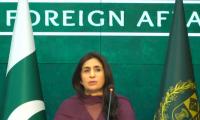Taking a break from our series on economic reforms, let’s analyse some important developments pointing to ominous dark clouds gathering on the horizon.
The two leading credit rating agencies, Moody’s and Fitch, both currently engaged in rating Pakistan’s economy, have recently either downgraded the outlook from ‘stable’ to ‘negative’ or issued a severe warning that things are slipping and only a small window of opportunity is available for taking corrective action.
Fitch has underlined that the recent actions of the central bank (raising policy rate by 0.75 percent in January and May, and three rounds of exchange rate adjustment totalling 16 percent) have been in the right direction, “but their magnitude so far has not been sufficient to prevent external finances deteriorating more sharply than we expected when we placed Pakistan’s sovereign rating of ‘B’ on Negative Outlook in January.”
Moody’s negative outlook came out in June. One may take it as a clear warning from Fitch that unless corrective measures are adopted soon, the agency may formally downgrade the country’s rating. The primary focus of the rating agencies are our declining reserves, rising current account deficit (six percent of GDP or Rs18 billion – highest in more than a decade) and high debt-servicing obligations.
They have also pointed out that the yields on Pakistan’s bonds are rising, which implies an increasing cost of borrowing. It is further highlighted that the recent foreign loans obtained by Pakistan from China’s policy banks at an exceptionally low pricing essentially means that China has been generous to help Pakistan at a difficult time. However, these loans will kick in for repayment starting 2019, together with the high repayments of IMF loans.
There are many other factors contributing to a negative economic outlook. First, the inflation numbers (5.2 percent) for June are pointing towards a sustained resurgence of inflationary pressures, which would be exacerbated by the rising international oil prices, depreciating rupee and pending increase in gas and electricity prices.
Second, it is reported that the fiscal deficit for the year is likely to end at 7.1 percent, or Rs2.5 trillion. This is sharply higher than the budget target of 4.1 percent, or Rs1.5 trillion, despite many claims by the former finance minister of the deficit being much lower – even at the time of budget presentation in April – in the last two months. Excluding the circular debt settlement, this is the highest deficit since 2012, when it was recorded at eight percent. Moreover, this has happened a second time in a row, pointing to a new wave of fiscal indiscipline in the country. Such rapid unravelling of the fiscal account soon after the completion of a three-year IMF programme, with a major fiscal adjustment of nearly four percent, is astonishing.
As heavy a dose of spending as nearly three percent over-run in the budget deficit – close to Rs1 trillion – has unleashed a high aggregate demand, most notably leading to an alarming rise in the external account deficit. In all likelihood, the deficit would close at $18 billion or six percent of GDP, highest in more than a decade. Consequently, SBP reserves have come down to below $10 billion, less than two months of imports. More importantly, we have absolutely no cushion from the shock that cannot be ruled out in view of what is happening in the international oil market, where crude prices have shot up by 64 percent since last July. In the backdrop of the sanctions approaching Iran, major banks are predicting that the price will reach $85 in the near future.
One thing that appeared to be performing well during the year were the FBR tax collections, showing a handsome growth of 16 percent during July-April, compared to only eight percent in 2016-17. This has taken a major beating. Tax collections are reported at Rs3.7 trillion, including receipts under the amnesty scheme of Rs72 billion. This means the actual collection is higher by only 10 percent compared to last year. With amnesty receipts the growth increases to 12 percent. Both these numbers are not impressive and follow the same poor performance as of eight percent last year, grossly below the 20 percent growth registered in the first three years of the previous government.
The tax shortfall, which is estimated at Rs248 billion, or 0.6 percent of GDP, has also contributed to the high fiscal deficit. Equally importantly, the non-tax revenues, most notably the Gas Infrastructure Development Cess, were significantly short as actual receipts in the first three quarters of the fiscal year amounted to only 39 percent of the budget. What is most worrying is the reported over-spending by both Punjab and Sindh – Rs50 billion and Rs10 billion, respectively – through overdraft from SBP. The provinces were supposed to provide a surplus of Rs300 billion. If these two provinces, with more than 75 percent of the divisible poor share, have over-spent then one can imagine that no surplus has been generated, and like last year, there would be an overall deficit from the provinces as well.
This again is a major factor contributing to the rising deficit. Curiously, this high level of deficit has been attained after making a significant cut in the development spending. A report recently released by the Planning Commission has indicated that nearly 25 percent of the development budget of Rs1 trillion was cut to accommodate the rising spending on current expenditures, perhaps for the payment of Rs200 billion to clear circular debt, as disclosed to a Senate standing committee.
The agenda of reforms required to be undertaken immediately by the new government is expanding. The tax momentum initially generated by the previous government has dissipated. Without a major overhaul in the tax policy and administration, tax revenues needed to transform the economy will not be available. In this regard, it is equally important to reverse the tax concession given by the previous government without proper consideration. In fact, the impact of those concessions in terms of loss of revenue will have to be borne by the new government, which will be fully justified in reviewing the concessions and taking a more considerate and judicious decision.
Unlike 2013, there is a strong momentum visible in the economy, in the growth rate as well as in investments and consumer spending. These strengths need to be nurtured by removing destabilising factors such as fiscal and external deficits and unrealistic policy and exchange rate.
Surely, this will call for painful adjustments but they are unavoidable. However, as we noted in Fitch’s warning, the window for taking corrective actions is really short. The new government would do well for itself if it immediately deployed its energies to work out the reforms programme and diligently implemented it without losing any time.
The writer is a former finance secretary. Email: waqarmkn@gmail.com
A woman walks past a building of the International Monetary Fund. — AFP/FileThe annual and spring meetings of the...
Late Benazir Bhutto's daughter Asifa Bhutto Zardari addresses the Christian community in Bihar Colony on January 23,...
Representational image. — PexelsWater is an important scarce natural resource that is required for several everyday...
Pakistani employees of online marketplace company Kaymu at work in Karachi. — AFP/FileThe true spirit of development...
India uses Afghanistan as a backstage area to carry out terrorist attacks against Pakistan
Another report by the Pakistan Institute of Peace Studies states that 78 per cent of attacks have been carried out by...







